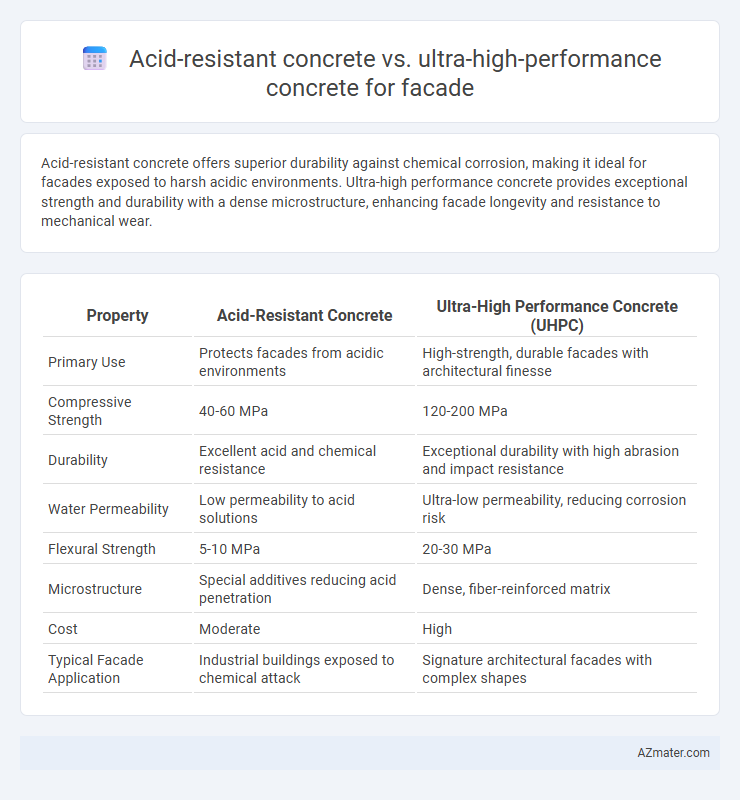Acid-resistant concrete offers superior durability against chemical corrosion, making it ideal for facades exposed to harsh acidic environments. Ultra-high performance concrete provides exceptional strength and durability with a dense microstructure, enhancing facade longevity and resistance to mechanical wear.
Table of Comparison
| Property | Acid-Resistant Concrete | Ultra-High Performance Concrete (UHPC) |
|---|---|---|
| Primary Use | Protects facades from acidic environments | High-strength, durable facades with architectural finesse |
| Compressive Strength | 40-60 MPa | 120-200 MPa |
| Durability | Excellent acid and chemical resistance | Exceptional durability with high abrasion and impact resistance |
| Water Permeability | Low permeability to acid solutions | Ultra-low permeability, reducing corrosion risk |
| Flexural Strength | 5-10 MPa | 20-30 MPa |
| Microstructure | Special additives reducing acid penetration | Dense, fiber-reinforced matrix |
| Cost | Moderate | High |
| Typical Facade Application | Industrial buildings exposed to chemical attack | Signature architectural facades with complex shapes |
Introduction to Advanced Concrete Solutions for Facades
Acid-resistant concrete offers superior protection against chemical corrosion, making it ideal for facades exposed to harsh industrial environments or acidic rain. Ultra-high performance concrete (UHPC) provides exceptional strength, durability, and aesthetic versatility, enabling sleek, thin-profile facades with enhanced structural integrity. Both materials represent advanced concrete solutions tailored to address specific performance requirements in modern architectural facade design.
Defining Acid-Resistant Concrete and Its Facade Applications
Acid-resistant concrete is specially formulated with chemical additives and aggregates that enhance its durability against acidic environments, making it ideal for facades exposed to industrial pollutants or acidic rain. It features low permeability and high resistance to chemical corrosion, protecting structural integrity and appearance over time. These properties enable acid-resistant concrete facades to maintain aesthetic quality and structural performance in harsh urban and industrial settings compared to traditional or ultra-high performance concrete.
Ultra-High Performance Concrete (UHPC): Features and Benefits for Facades
Ultra-High Performance Concrete (UHPC) offers exceptional durability, high compressive strength exceeding 150 MPa, and superior resistance to environmental degradation, making it ideal for demanding facade applications. Its dense microstructure significantly reduces porosity, providing enhanced protection against acid attack compared to traditional acid-resistant concrete. UHPC's versatility allows for thinner panels with intricate designs, improved aesthetics, and extended facade lifespan with minimal maintenance.
Durability Comparison: Acid-Resistant vs. UHPC in Aggressive Environments
Acid-resistant concrete features specialized cementitious materials and additives that enhance its resistance to chemical attack, making it suitable for facades exposed to acidic or industrial environments. Ultra-high performance concrete (UHPC) offers superior mechanical strength and extremely low porosity, providing excellent durability against both chemical and physical degradation in aggressive settings. While acid-resistant concrete excels in withstanding specific corrosive substances, UHPC delivers a broader range of durability benefits, including enhanced abrasion resistance and structural longevity under harsh environmental conditions.
Architectural Flexibility and Aesthetic Potential
Acid-resistant concrete offers exceptional durability in harsh chemical environments, making it ideal for facades exposed to industrial pollutants, while its formulation allows moderate architectural flexibility with textured finishes. Ultra-high performance concrete (UHPC) provides superior mechanical strength and enhanced ductility, enabling thinner, more intricate facade designs with smooth, visually striking surfaces that support high aesthetic potential. Both materials advance architectural creativity, but UHPC's capacity for complex geometries and refined finishes offers greater versatility for innovative facade applications.
Structural Performance in Facade Systems
Acid-resistant concrete offers superior durability and chemical stability for facade systems exposed to harsh environments, ensuring long-term protection against corrosion and degradation. Ultra-high performance concrete (UHPC) excels in structural performance with its exceptional compressive strength above 150 MPa and enhanced tensile properties, allowing for thinner, lighter facade elements without compromising load-bearing capacity. Combining acid resistance with UHPC technology optimizes facade durability and structural integrity, reducing maintenance costs and extending service life.
Maintenance Demands and Longevity Expectations
Acid-resistant concrete offers exceptional durability against chemical corrosion, making it ideal for facades exposed to harsh industrial environments, but it may require periodic maintenance to address surface wear and potential microcracking. Ultra-high performance concrete (UHPC) provides superior mechanical strength and minimal permeability, significantly reducing maintenance demands and extending facade longevity beyond 50 years in most urban and corrosive conditions. Both materials enhance facade lifespan, but UHPC's dense matrix structure typically ensures lower lifecycle costs through reduced repair frequency and enhanced resistance to environmental degradation.
Cost Implications and Lifecycle Analysis
Acid-resistant concrete offers enhanced chemical durability for facades exposed to harsh environments, typically presenting a lower initial cost compared to ultra-high performance concrete (UHPC). UHPC provides superior strength, durability, and reduced permeability, leading to extended service life and reduced maintenance expenses, which can offset its higher upfront cost through lifecycle savings. Lifecycle analysis reveals that while acid-resistant concrete incurs frequent repairs and replacements due to chemical degradation, UHPC's longevity and resilience contribute to overall cost-effectiveness in facade applications over time.
Sustainability Considerations and Environmental Impact
Acid-resistant concrete for facades offers enhanced durability against chemical erosion, reducing the frequency of repairs and associated resource consumption, thereby contributing to long-term sustainability. Ultra-high performance concrete (UHPC) provides superior strength and longevity with a reduced material volume, lowering carbon footprint through decreased cement usage and extended facade lifespan. Selecting between acid-resistant concrete and UHPC involves balancing environmental impacts like embodied energy, lifecycle emissions, and recyclability to optimize sustainable building envelope solutions.
Choosing the Optimal Concrete Type for Facade Projects
Acid-resistant concrete offers superior chemical durability to protect facades in industrial or corrosive environments, while ultra-high performance concrete (UHPC) provides exceptional mechanical strength, durability, and aesthetic versatility for architectural designs. Choosing the optimal concrete type for facade projects depends on environmental exposure and specific performance requirements, with acid-resistant concrete preferred for aggressive chemical conditions and UHPC favored for demanding structural integrity and sleek finishes. Evaluating factors such as longevity, maintenance, cost, and design flexibility ensures the selection of the most suitable concrete technology for facade applications.

Infographic: Acid-resistant concrete vs Ultra-high performance concrete for Facade
 azmater.com
azmater.com